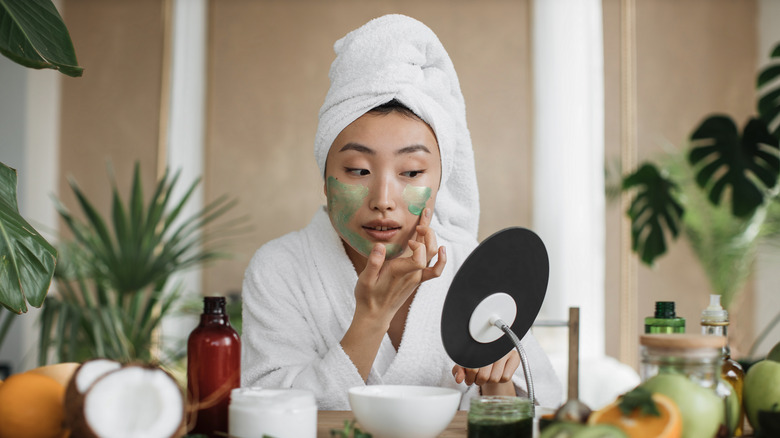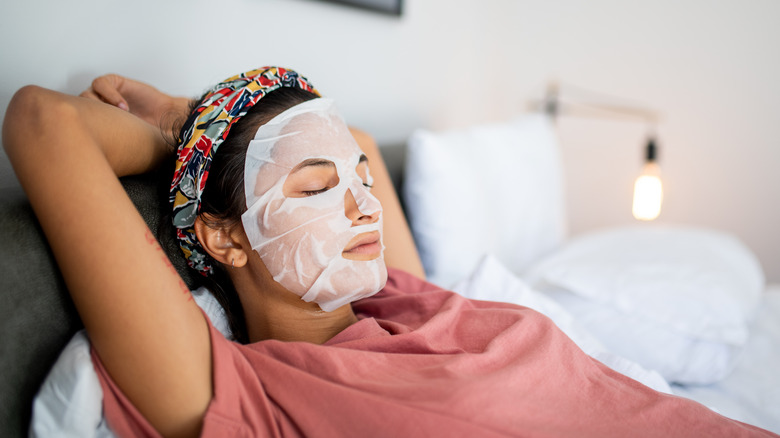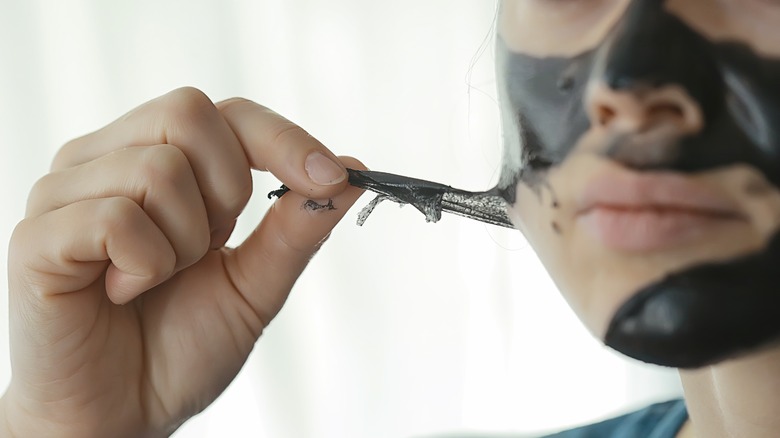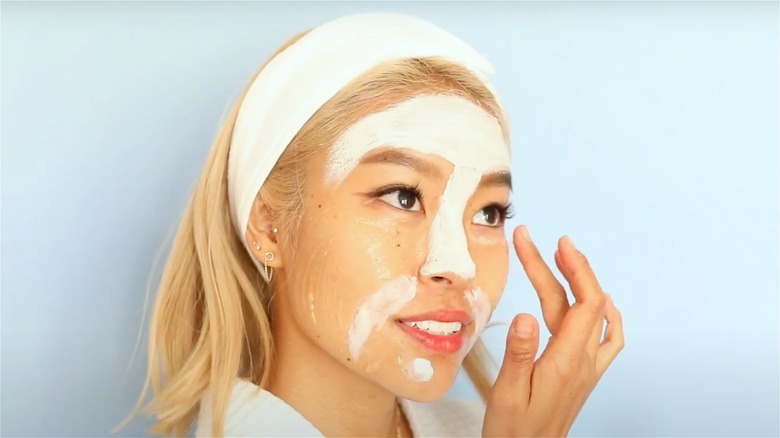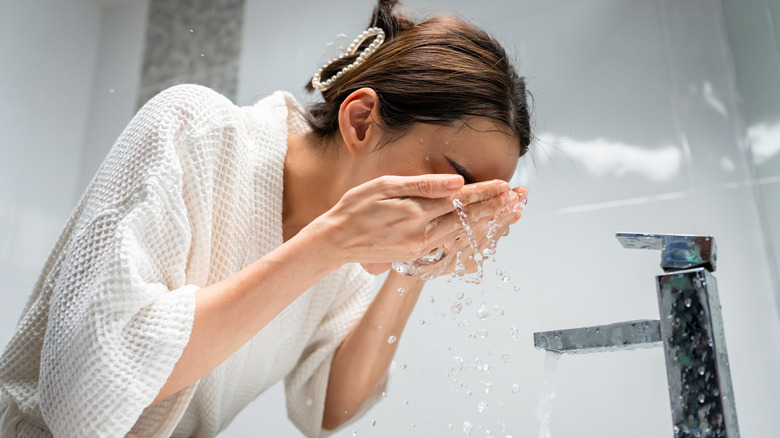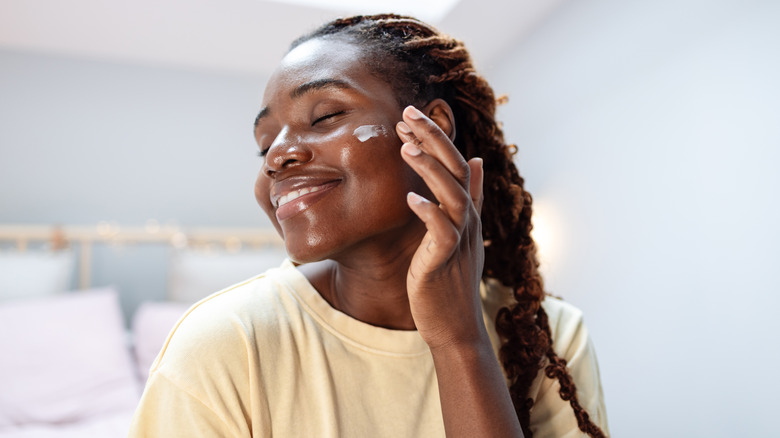Mistakes Everyone Makes With Face Masks
Sometimes, all you need after a stressful day is to wind down with an at-home spa day, and nothing says "self-care pampering sesh" quite like a face mask. Luxuriating in a post-mask glow before bed is the perfect way to recreate a spa getaway feeling while constrained to a budget, and you can even create a DIY face mask with ingredients you already have at home. That said, many folks don't actually get the most out of their face masks due to a few common mistakes, such as buying the wrong mask for their skin type.
Luckily, Glam reached out to Beverly Hills-based facial plastic surgeon Dr. Patrick Davis to learn the most-effective methods for applying face masks. During our exclusive chat, Dr. Davis explains that when it comes to face masks, people tend to forget the importance of adequate skin prep, product formulation, and more. These common misconceptions prevent you from attaining the masks' maximum skin benefits and, in some cases, can even damage your skin.
Mistake: Keeping your mask on longer or shorter than you should
According to Dr. Patrick Davis, the instructions on your skincare products do, in fact, serve a purpose, and this is especially true with face masks. "These masks have an increased amount of active ingredient[s] than your normal routine skincare," Dr. Davis explains during an exclusive chat with Glam. "Keep it on too short and you won't get the benefits, but on the other hand, leaving it on overnight, for example, may result in irritation." Indeed, certain face masks can strip your skin of moisture, resulting in irritation or itchiness. You can prevent your face mask from drying out your skin by following its recommended usage guidelines. From there, feel free to adjust the time you wear the mask based on how your skin responds to the product.
"The exception is if the mask is specifically designed for sleeping, as in sleeping masks," Dr. Davis adds. "If that's the case, go for it!" Overnight masks tend to offer more hydration than those designed to exfoliate the skin, as they're formulated with ingredients like ceramides and hyaluronic acid, meaning they're less likely to cause irritation.
Mistake: Using peel-off masks when you have sensitive skin
No one can blame you for admitting your preference for peel-off masks because, hey, we get it. Peel-off face masks are incredibly satisfying to use, albeit slightly painful, and they target stubborn blackheads and whiteheads. However, Dr. Patrick Davis says that peel-off face masks can spell disaster for super-sensitive skin. "These types of masks work by removing the outer layer, the stratum corneum, of the skin. This is a type of exfoliation," Dr. Davis explains exclusively to Glam. "However, sensitive skin can become irritated." Therefore, Dr. Davis warns those prone to sensitivity to beware of peel-off masks.
That said, it might be in your best interest to skip over that peel-off face mask in your beauty drawer anyway, as over-exfoliation can result in irritation and redness even for those with normal skin types. When you pry the dried mask film from your face, you physically tug at the skin, and this, combined with exfoliating ingredients such as charcoal, increases the risk of irritation and peeling.
Mistake: Using the wrong face mask for your skin type
People who are just beginning their face-mask journey typically make the mistake of using the wrong face mask. "There are a dizzying array of face masks," Dr. Patrick Davis shares exclusively with Glam. "[F]ind one for your skin type!" That may sound difficult, but determining your skin type is actually pretty easy; searching for a face mask that's compatible with your skin is the tricky part. Masks come in various formulations, so it helps to understand the benefits of each option. "If your skin is oily, an earth or clay mask would be excellent," says Dr. Davis, "and if you're on the drier side, then consider a mask designed for hydration."
Those with oily and acne-prone skin can get away with using clay or mud masks more often without damaging their skin, whereas someone with dry or sensitive skin might find them too drying. On the other hand, a hydrating cream mask or overnight mask is more suitable for individuals with dry and sensitive skin types. And if you have combination skin, multimasking may be exactly what your skin needs.
Mistake: Not cleaning and exfoliating your skin beforehand
"Skin prep is absolutely crucial. This rule not only applies for face masks, but also for your general skincare routine," Dr. Patrick Davis reveals exclusively to Glam. All beauty veterans know how important it is to prepare the skin before applying makeup, and the same concept applies here. You should always cleanse and exfoliate the skin if you're planning on using a face mask. "Removing the outer layer of skin allows the active ingredients to penetrate more effectively," Dr. Davis explains. "Additionally, if your skin is dirty with clogged pores, the ingredients will not penetrate the skin as effectively."
"As a general rule, with the exception [of] very sensitive skin, I recommend daily exfoliation as part of your general skincare routine," says Dr. Davis. So, if you have sensitive skin and you already exfoliated earlier in the week, there's no need to exfoliate again before using your face mask, as this might increase sensitivity. If you do exfoliate beforehand, try a gentle chemical exfoliant, such as lactic acid.
Mistake: Skipping a post-mask routine
Neglecting to follow through with your regular skincare routine after washing off a face mask is generally frowned upon by skin experts. "At the very least, it is important to thoroughly clean your skin after wearing the mask and not [go] to bed with residue still on your skin," says Dr. Patrick Davis during our exclusive chat. This is especially true for rinse-off masks, which tend to leave behind a residue. You don't need to cleanse after a sheet mask, however, as they contain hydrating ingredients that should remain on the skin, allowing them to fully penetrate the skin barrier.
For all other masks, such as clay, gel, or cream formulations, thoroughly rinse your face with water and pat it dry with a face towel. If leaving the ingredients on your skin makes you break out, you probably need to use a cleanser. "You can use a gentle cleanser, and then apply your favorite moisturizer, as even the most hydrating masks can dry your skin," Dr. Davis adds. "Additionally, if the mask has additional serums to add afterward, don't forget these." With this in mind, you should be able to get the most out of your face masks each and every time you use them.
